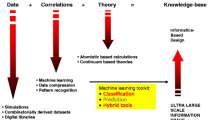Abstract
There is a strong desire within the metal additive manufacturing industry to immediately leverage research discoveries to improve process and part quality. Rapid transfer of knowledge from a university setting to a factory floor is greatly enhanced if researchers have direct access to the same type of equipment being used by industry. Challengingly, the operation of much of this equipment requires specially designed facilities—the specifications for which are not well reported in the prior literature. Informed by their recent experience of constructing a new metal additive manufacturing research laboratory, the authors enumerate many of the design challenges they faced and the solutions they implemented.




Similar content being viewed by others
Notes
Often classified as flammable solids.12
This value is based on a conservative interpretation of guidelines from the National Fire Protection Agency.14
Provided that such enclosures remain non-flammable.
Because many AM machines reject significant amounts of heat into the surrounding area via chillers, more substantial air conditioning resources may need to be allocated than is typical for a similarly sized laboratory.
References
P. Zelinski, Additive manufacturing belongs in a machine shop (Modern Machine Shop, 2017), http://www.mmsonline.com/articles/additive-manufacturing-belongs-in-a-machine-shop. Accessed 6 Aug 2017.
R.E. Laureijs, J. Bonnín Roca, S. Prabha Narra, C. Montgomery, J.L. Beuth, and E.R.H. Fuchs, J. Manuf. Sci. Eng. (2016). https://doi.org/10.1115/1.4035420.
D. Bourell, M. Leu, and D. Rosen, Roadmap for additive manufacturing: identifying the future of freeform processing (The University of Texas at Austin, 2009), http://wohlersassociates.com/roadmap2009A.pdf. Accessed 23 May 2017.
S. Moylan, K. Jurrens, S. Moylan, A. Cooke, and K. Jurrens, Lessons learned in establishing the NIST metal additive manufacturing laboratory (The National Institute of Standards and Technology, 2013) https://nvlpubs.nist.gov/nistpubs/TechnicalNotes/NIST.TN.1801.pdf. Accessed 2 Aug 2017.
P. Azimi, D. Zhao, C. Pouzet, N.E. Crain, and B. Stephens, Environ. Sci. Technol. (2016). https://doi.org/10.1111/jiec.12498.
C. Hamby, Unchecked dust explosions kill, injure hundreds of workers (The Center for Public Integrity, 2012), https://www.publicintegrity.org/2012/05/29/8957/unchecked-dust-explosions-kill-injure-hundreds-workers. Accessed 4 Aug 2017.
Safety data sheet EOS Ti64/Ti64ELI (EOS GmbH, 2015).
A. Hall, Powder safety awareness for additive manufacturing (Sandia National Laboratories, 2014), https://www.osti.gov/scitech/servlets/purl/1242062. Accessed 4 Aug 2017.
Safety data sheet EOS In625 (EOS GmbH, 2012).
P. Graff, B. Ståhlbom, E. Nordenberg, A. Graichen, P. Johansson, and H. Karlsson, J. Ind. Ecol. (2017). https://doi.org/10.1111/jiec.12498.
Special detailed requirements based on use and occupancy: hazardous materials §414.2 (International Building Code, 2006).
Use and occupancy classification: high-hazard group H §307 (International Building Code, 2009).
I. Wolff, Breathing safely around metal 3D printers (AdditiveManufacturing.org, 2016), http://advancedmanufacturing.org/breathing-safely-around-metal-3d-printers/. Accessed 4 Aug 2017.
NFPA 400: hazardous materials code (National Fire Protection Agency, 2016).
Immersion Separator and Wet Vacuums (Ruwac, 2016), http://explosionproofvacuums.com/products/immersion-separators-a-wet-collection. Accessed 13 Aug 2017.
Safety data sheet ExOne aqueous binder 05 (ExOne, 2015).
R.J. Hebert, J. Mater. Sci. (2016). https://doi.org/10.1007/s10853-015-9479-x.
Technology overview (ExOne, 2018), http://www.exone.com/Resources/Technology-Overview. Accessed 4 Jan 2018.
Acknowledgements
Ideas for the design of the NextManufacturing Center’s Additive Manufacturing Laboratory originated from a variety of sources. In particular the authors would like to thank the following individuals for their contributions: Tara Balonick, Debomita Basu, Dr. Brian Fisher, Dr. Zachary Francis, Jeffery Harris, Dr. Colt Montgomery, Dr. Sneha Prabha Narra, Michael Patrick, Prof. Allen Robinson, and Edward Wojciechowski of CMU; Mick McNutt of GBBN Architects; Joseph Gaus, A.J. Kryzosiak, and Carl Thieret of CJL Engineering; Mark Rayburn and Kevin Shaffer of Rycon Construction; and Cliff Humes, Bob Kappas, Tim Kunz, and Bob Oddis of various sub-contractors.
Author information
Authors and Affiliations
Corresponding author
Rights and permissions
About this article
Cite this article
Scime, L., Wolf, S.D., Beuth, J. et al. Safety and Workflow Considerations for Modern Metal Additive Manufacturing Facilities. JOM 70, 1830–1834 (2018). https://doi.org/10.1007/s11837-018-2971-4
Received:
Accepted:
Published:
Issue Date:
DOI: https://doi.org/10.1007/s11837-018-2971-4




